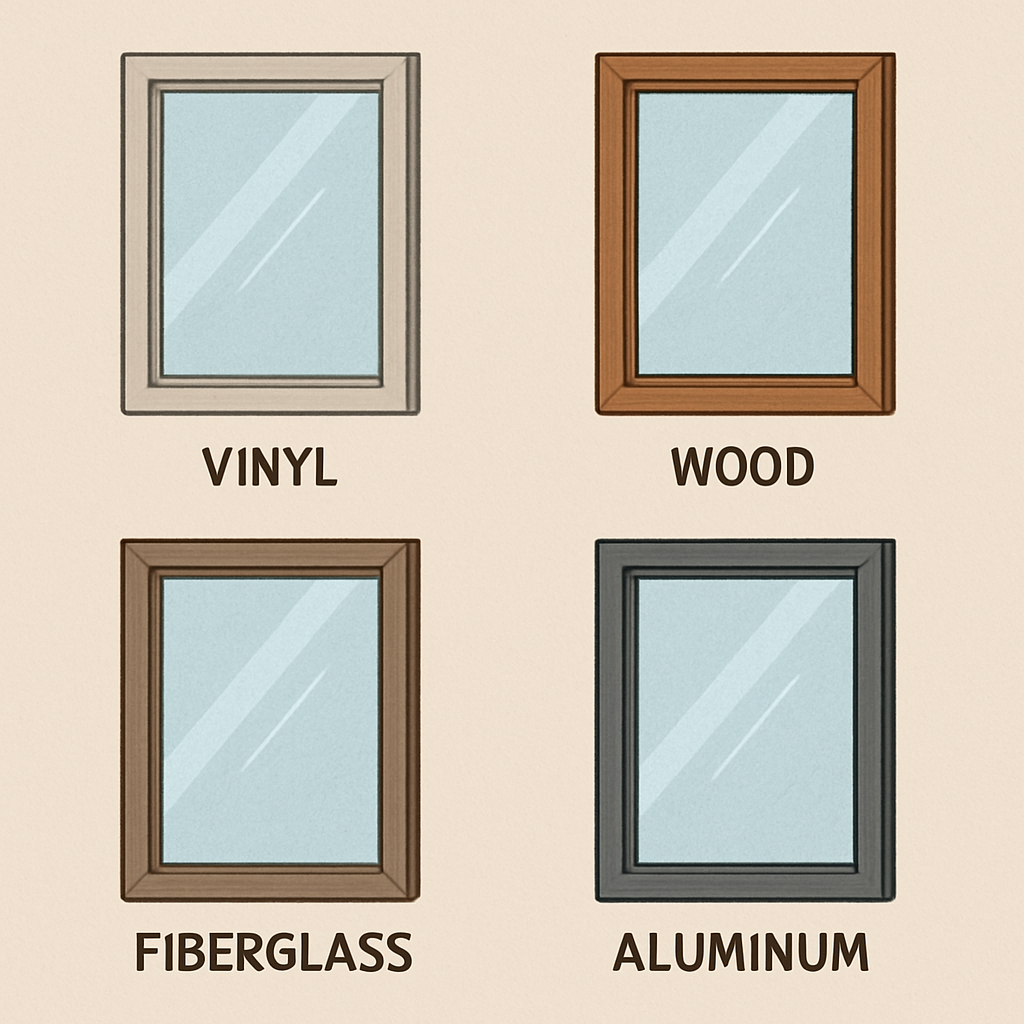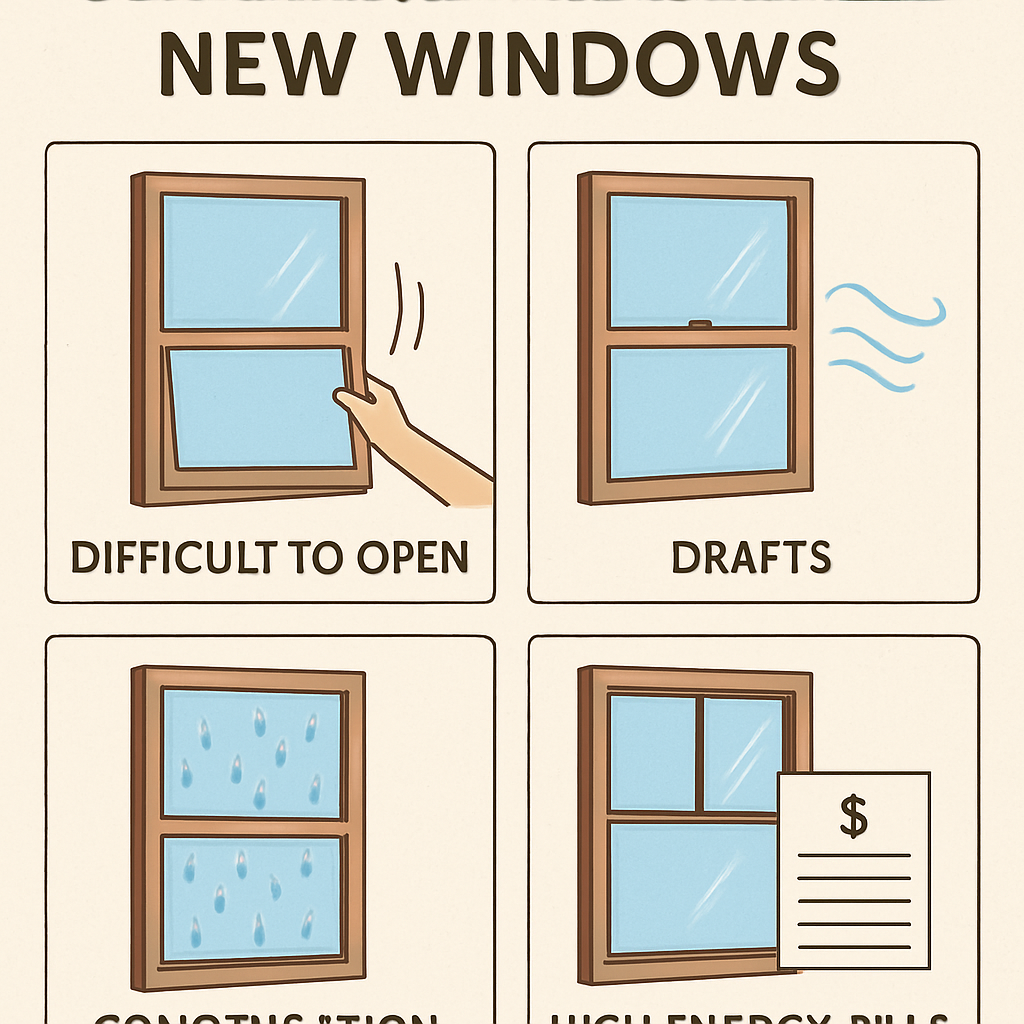Windows are a crucial part of any home. They provide light, ventilation, and a view of the outside world. But how do you know when it’s time to replace them?
Old or damaged windows can lead to higher energy bills. They can also make your home less comfortable. Drafts, condensation, and difficulty opening or closing are common signs of window issues.
Replacing windows can be a significant investment. However, it can also offer substantial benefits. New windows can improve energy efficiency and increase your home’s value.
Understanding window replacement costs is essential. It helps you plan your budget and make informed decisions. Costs can vary based on materials, labor, and window type.
Energy-efficient windows can reduce energy bills by up to 15%. They also enhance comfort and reduce noise. This makes them a smart choice for many homeowners.
The return on investment (ROI) for window replacement can be high. It often ranges from 70% to 80% upon resale. This makes it a worthwhile home improvement project.
In this guide, we’ll explore the signs you need new windows. We’ll also discuss costs, benefits, and how to choose the best windows for your home.
How Long Do Windows Last? Understanding Window Lifespan
Windows aren’t eternal. Their lifespan varies based on materials and maintenance. Generally, windows last between 15 to 30 years. However, this depends greatly on how well they are cared for.
Material choice affects durability. For instance, wood windows may require more maintenance but can last long if maintained. Vinyl windows, on the other hand, offer durability with less upkeep. Fiberglass also provides a long lifespan and requires minimal maintenance.
Here are some typical lifespans based on window materials:
- Wood Windows: 15 to 30 years
- Vinyl Windows: 20 to 40 years
- Fiberglass Windows: 30 to 50 years
Environmental conditions also play a role. Frequent exposure to harsh weather can reduce window lifespan. Regular inspections and timely repairs prolong their usability. It’s crucial to address minor damages early to avoid larger issues.
Routine maintenance can enhance longevity. This includes cleaning, resealing, and painting when necessary. These practices can significantly extend the life of your windows, ensuring they perform optimally for many years.
Signs You Need New Windows: When Is It Time to Replace?
Recognizing when your windows need replacement is crucial. Failing windows can lead to energy loss and comfort issues in your home. Look for key signs indicating it’s time for new windows.
Drafts and cold spots near windows are common indicators. You may notice that the space around your windows feels cooler than the rest of your house. This usually means your windows aren’t insulating well.
Condensation between double panes is another red flag. This often signals a seal failure. Once the seal fails, moisture infiltrates, compromising the window’s efficiency.
Here are some other signs:
- Difficulty Operating: Windows that stick or won’t stay open.
- Visible Damage: Cracks or rotting frames signal urgent replacement.
Increased outside noise can also suggest inefficient windows. Quality windows provide sound insulation, keeping external sounds muted. If noises become more noticeable, your windows might not be in their prime condition anymore.
Check your energy bills as well. A sudden spike might indicate your windows are losing energy. Energy-efficient windows can help reduce heating and cooling costs.
- Fading Furnishings: Sunlight that fades carpets or furniture.
- Frequent Repairs: Constantly fixing windows might be costlier than replacement.
Aesthetics and curb appeal can deteriorate with old, unappealing windows. Outdated windows often clash with modern homes, impacting not just looks but also property value. New windows can significantly enhance a home’s visual appeal and market value.
To summarize, replace windows when you spot these signs. Doing so improves energy efficiency, comfort, and home value. Prompt action on window replacement saves money in the long run and upgrades your living space considerably.
Common Window Problems: Repair or Replace?
Evaluating whether to repair or replace windows hinges on the severity of the issue. Some problems may seem minor but can escalate, demanding immediate attention.
Drafty windows are a typical concern. They can often be repaired by sealing gaps or adding weatherstripping. However, if drafts persist, replacement might be the better long-term solution.
Broken or cracked glass also poses a dilemma. Small cracks might be fixed temporarily. But for significant damage, replacing the glass or entire window is often safer and more effective.
Factors to Consider for Repair:
- Minor Seal Failures: Could be resolved with sealant.
- Single Pane Damage: Easier to repair than multi-pane windows.
Window condensation can be a nuisance, especially between panes. This typically indicates a failure in the window seal. Repairing seals might work briefly, but replacing the window ensures lasting results.
Old frames may suffer from rot or warping. Minor rot can sometimes be salvaged through patching and painting. However, extensive damage compromises the structure, making replacement more advisable.
When Replacement Makes Sense:
- Extensive Rot or Warping: Often necessitates full frame replacement.
- Persistent Noise Issues: New, quality windows provide better soundproofing.
When deciding between window repair or replacement, factor in the age of the windows. Older windows, especially if over 15 years, often warrant replacement for better energy efficiency and aesthetics.
In conclusion, repairs can be sufficient for minor issues but remember they are usually temporary. Replacing windows addresses multiple problems comprehensively and efficiently, enhancing both energy efficiency and home comfort in the long run. Balancing short-term costs with potential long-term savings is key when making this decision.
Window Replacement Costs: What to Expect in 2025
With each year, window replacement costs can fluctuate due to market trends and material availability. Understanding what to expect in 2025 can help plan your budget effectively.
In 2025, expect window replacement costs to range between $300 and $1,000 per window. This estimate includes materials and labor, which will vary based on window type and customization.
Factors Affecting Costs:
- Material Type: Vinyl windows are more affordable compared to wood or fiberglass.
- Installation Complexity: Larger or custom-shaped windows increase labor costs.
Double-pane windows remain popular for their insulation benefits. Despite a higher price, they offer substantial energy savings. In 2025, the average cost for double-pane window replacement may rise slightly due to improved technology.
Wooden windows add classic appeal and are favored in older or historic homes. However, they can be pricey. Expect the cost of wooden windows to be on the higher end of the spectrum next year.
Vinyl is a budget-friendly option for many homeowners. It provides great value given its durability and energy efficiency. Vinyl windows are typically at the lower end of the cost scale, making them a common choice.
Cost Elements to Consider:
- Glass Type: Double or triple glazing and low-E coatings can increase prices.
- Labor Rates: Regional labor costs can vary significantly.
Specialty windows, like bay or bow windows, are a different story. Their elaborate design demands more materials and labor. Thus, you should prepare for higher costs if opting for these types.
In addition to window type and material, geographical location impacts pricing. Areas with a higher cost of living might have steeper installation charges.
Consider timing your purchase. During off-peak seasons, discounts and promotions are more prevalent, which can significantly reduce expenses.
Overall, window replacement costs in 2025 are expected to follow current trends. By understanding these elements, you can better navigate the market and make informed financial decisions for your home.
Cost Breakdown: By Window Type, Material, and Glass
The cost of window replacement largely depends on the type of window, the materials used, and the glass options chosen. To make informed decisions, understanding each component’s cost is crucial.
Breakdown by Window Type:
1. Single-Hung Windows:
These are the most affordable option and are characterized by a single moving sash.
- Cost Range: $200 – $500 per window.
2. Double-Hung Windows:
They allow both sashes to move, offering better ventilation.
- Cost Range: $400 – $900 per window.
3. Casement Windows:
These swing open like a door and provide excellent ventilation.
- Cost Range: $300 – $800 per window.

Breakdown by Material:
1. Vinyl:
Known for low cost and good insulation.
- Price Range: $300 – $700 per window.
2. Wood:
Offers natural beauty but requires maintenance.
- Price Range: $800 – $1,200 per window.
3. Aluminum:
Durable and sleek but less energy-efficient.
- Price Range: $400 – $1,000 per window.
The choice of material affects both aesthetic appeal and long-term maintenance costs. Vinyl and aluminum are easy to maintain, while wood needs regular care to prevent rot.
Glass Options:
1. Single Pane:
Least energy-efficient but cheaper.
- Cost Range: Included in basic pricing; generally not recommended for most climates.
2. Double Pane:
Provides a good balance between cost and energy savings.
- Additional Cost: Around $100 – $400 more per window.
3. Triple Pane:
Superior insulation but pricier.
- Additional Cost: Approximately $400 – $800 more per window.

The efficiency gains from double and triple-pane options often justify their additional cost. For colder climates, these options quickly balance initial expenses with savings on energy bills.
Additional Cost Considerations
- Low-E Coatings: Add around $50 – $100 per window, reducing UV and infrared light.
- Custom Shapes: Non-standard shapes can increase costs by up to 50%.
Balancing quality, cost, and aesthetics is vital. Consider both immediate costs and long-term savings when selecting window types, materials, and glass for your project. Thoughtful choices can enhance home comfort and energy efficiency for decades.
Affordable Window Replacement: Tips to Save Money
Finding ways to replace your windows affordably can make a substantial difference in costs. With careful planning and research, you can achieve a budget-friendly upgrade.
1. Compare Quotes:
Contact multiple window contractors to compare prices.
- Look for local installers with good reviews.
- Ensure quotes include installation and any extra services.
2. Off-Season Deals:
Window companies often offer discounts during slower seasons.
- Plan your project in late fall or winter for potential savings.
- Watch for seasonal sales or promotions to cut costs.
3. Opt for Standard Sizes:
Custom-sized windows can significantly increase expenses.
- Use standard sizes whenever possible.
- This reduces both material and labor costs.
Additional strategies include selecting cost-effective materials like vinyl or aluminum. These materials offer durability and energy efficiency at a lower price compared to wood. Vinyl, in particular, provides excellent insulation properties with minimal upkeep, making it an ideal choice for many homeowners.
Eco-Friendly Incentives:
Explore available tax credits for installing energy-efficient windows.
- Check for rebates from utility companies.
- These incentives can offset some of the upfront costs.
Considering these tips can help you achieve a home window upgrade without breaking the bank. Well-planned replacements not only enhance home aesthetics but also improve energy efficiency, offering long-term savings on utility bills.
Energy Efficient Windows: Benefits and Savings
Upgrading to energy efficient windows offers numerous advantages. These windows are designed to minimize heat loss and maximize comfort.
1. Lower Energy Bills:
Energy efficient windows can reduce heating and cooling costs.
- They help maintain consistent indoor temperatures.
- Expect up to a 15% reduction in energy bills annually.
2. Environmental Impact:
These windows contribute to a reduced carbon footprint.
- Less energy consumption means fewer emissions.
- Opting for such windows supports a more sustainable home.
3. Enhanced Comfort:
Energy efficient windows improve indoor comfort levels.
- They minimize drafts and cold spots.
- This leads to a more consistent home temperature year-round.

4. Increased Home Value:
Investing in energy efficient windows can boost property value.
- Potential buyers prioritize homes with energy-saving features.
- This makes your home more attractive in the real estate market.
5. Health Benefits:
Improved insulation reduces external noise levels and allergens.
- Quieter indoor environments contribute to better mental well-being.
- Enhanced air quality benefits overall health.
With numerous advantages, energy efficient windows not only offer tangible savings but also enhance the quality of life. When planning a window upgrade, consider these windows to improve comfort and sustainability while benefiting financially.
Window Replacement ROI: How Much Value Will You Gain?
Investing in new windows can significantly enhance a home’s market value. However, understanding the return on investment (ROI) is crucial for making an informed decision.
Replacing old windows with new, energy-efficient models can yield a high ROI. In many cases, homeowners enjoy a return of 70-80% upon resale. This means the home’s value increases, covering most of the initial costs.
Factors Influencing ROI:
- Type of Windows Installed: High-quality models yield better returns.
- Energy Savings: Reduced utility bills contribute to financial gains.
- Market Conditions: Local real estate trends can impact ROI.
Additionally, improving a home’s aesthetic appeal boosts curb appeal. Potential buyers are drawn to modern, efficient windows, making your property more competitive.
In summary, replacing windows is not merely an expense. It’s a strategic investment with substantial potential payoffs, both financially and in terms of comfort and sustainability. Consider these factors when evaluating whether to proceed with a window upgrade.
Choosing the Best Windows for Your Home
Selecting the right windows involves considering several vital factors. Your choice should match your home’s style, budget, and specific needs.
Materials play a crucial role in window performance and cost. Vinyl, wood, and fiberglass are popular choices. Each material offers unique benefits, such as durability, insulation properties, and aesthetic appeal.
Factors to Consider:
- Climate: Some materials perform better in certain climates.
- Maintenance: Wood requires more upkeep than vinyl or fiberglass.
- Energy Efficiency: Double-pane and triple-pane windows provide superior insulation.
Another consideration is the window style. Options include casement, sliding, and double-hung windows. Each design has pros and cons depending on ventilation needs and ease of use.

Lastly, ensure that windows are energy efficient. They can reduce utility bills and enhance indoor comfort. Look for Energy Star-rated models for optimal performance. Making the right selection can profoundly impact your home’s appearance and energy consumption. With careful selection, your home can enjoy a stylish upgrade and improved efficiency.
Window Installation: DIY vs. Professional
Installing windows can be challenging. Some homeowners consider DIY installation to save money. However, without experience, DIY can lead to costly errors.
Professionals bring expertise and tools to the job. They understand how to fit windows properly, ensuring an airtight seal. This expertise can prevent future issues like drafts and moisture intrusion.
Pros and Cons of Each Approach:
- DIY: Cost-saving, learning opportunity but risky with no experience.
- Professional: Higher upfront cost, but guaranteed quality and faster completion.
Another factor to consider is time. DIY projects can take longer, especially if unexpected problems arise. Professionals typically complete the work efficiently. In many cases, hiring a pro can save you both time and future repair costs. Choose a method that aligns with your skills, budget, and time constraints.
How to Find the Right Window Installer Near You
Choosing the right window installer is crucial for a successful replacement project. A quality installation ensures windows function perfectly for years to come. Start by gathering recommendations from friends and neighbors who have recently replaced windows.
Another effective approach is exploring online resources. Numerous review sites and local directories provide insights into contractors’ reputations. Reading customer reviews can reveal the strengths and weaknesses of potential installers.
Tips for Selecting a Window Installer:
- Check online reviews and ratings.
- Verify licenses and insurance.
- Request multiple quotes for comparison.
Interview a few candidates to discuss your needs and expectations. Ask about their experience with your specific type of windows. Clear communication can help prevent misunderstandings. Taking these steps increases your chances of choosing an installer who meets your requirements and delivers quality work.
Frequently Asked Questions About Window Replacement
How long do windows typically last? Most windows can last between 15 to 30 years. This depends on the materials and care they receive.
What are the main signs indicating replacement is necessary? Look for drafts, condensation, difficulty operating, and visible damage as telltale signs.
Is window replacement more cost-effective than repair? It often depends on the extent of damage. For minor issues, drafty window repair might suffice. However, frequent problems may justify complete replacement.
How much does it cost to replace a window? The average cost to replace windows ranges from $300 to $1,000 per window. The exact figure varies by materials and labor.
What are the benefits of window replacement? Benefits include increased energy efficiency, improved home value, and enhanced curb appeal.
Do energy-efficient windows provide significant savings? Yes, energy-efficient windows can reduce energy bills by up to 15%.
How can I find a reliable window installer? Check online reviews, ask for referrals, and verify qualifications before making a decision.
Conclusion: Is Now the Right Time for a Home Window Upgrade?
Deciding to replace your windows can be challenging. But understanding the signs and benefits can ease the decision. If your windows are showing signs of wear, it might be time for an upgrade.
Consider the overall cost and compare it with the potential savings on energy bills. New, energy-efficient windows can offer substantial returns, both in savings and increased home value.
If you’re experiencing frequent issues or wish to boost energy efficiency, replacing old windows is wise. Take time to assess your needs, review options, and find the best solution for your home. Investing in new windows now could bring comfort, savings, and future value.






